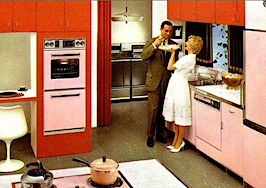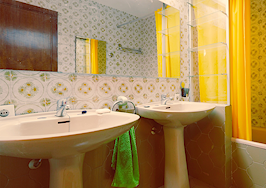New markets require new approaches and tactics. Experts and industry leaders take the stage at Inman Connect New York in January to help navigate the market shift — and prepare for the next one. Meet the moment and join us. Register here.
The real estate agent who is equipped with knowledge about housing styles and periods can be much more competitive in the market than the uniformed realtor. Houses built in the 1980s were, on the whole, 20 percent larger than those built just 10 years prior, with three bedrooms, a living room, a family room, and a recreation room.
Larger plots of land came with most houses, as well as double garages. As Americans prospered, they desired larger homes and more storage, so garages became storage areas as opposed to places to keep cars.
Maximalist
The 1980s can be characterized as a “more is more” period with innovative building techniques and styles. Energy-efficient construction, better insulation, and newer materials such as vinyl siding and thin decorative brick cladding for exteriors came into use.
Better vapor lock windows were available, allowing larger fenestration and more use of skylights. While traditional center hall Colonial houses were still being built, architects expanded into post-modernism, which incorporated classical elements, such as columns, used in new ways.
Bright colors were commonly used in the 80s as an expression of youth and optimism. Pastels, in particular, were popular as well as large, loud patterns in fabrics and home furnishings. Cathedral ceilings were in demand in new homes, and track lighting and wall-to-wall carpet were seen in most homes.
What’s cooking?
Kitchens continued to be larger and were brighter and whiter. The most commonly seen kitchen cabinet style, in both new construction and renovations, was a vanilla-colored plastic laminate door or drawer front with a light oak strip at the bottom.
Honey oak cabinets, with matching floors, were the second most popular kitchen cabinet material. The kitchen pantry cabinet with fold-out storage doors was introduced to hold a family’s canned and packaged food.
This full-size cabinet was typically placed next to the refrigerator and was similar in size to a side-by-side fridge. Ceramic tile countertops and backsplashes, often with a floral or geometric pattern, accompanied the laminate or wood cabinets.
The “country kitchen” style, with tiled range hoods and liberal use of brick as a wall surface, was seen in many higher-end houses. Heavy wood cabinets with moldings were used in traditionally styled homes, while slick “European style” cabinets of laminate or lacquer started to enter the marketplace.
These cabinets featured molded plastic drawer dividers and adjustable shelving. Some wall cabinets were hinged to open at the top rather than the side. This was an innovation requiring new types of hardware and hydraulic lift hinges.
Innovations and trends
Appliance colors were toned down, with minimalist beige, almond, white and black being the top sellers. Microwave ovens were used by the most innovative homeowners, many of whom were concerned about health hazards that could result from these devices.
The built-in microwave had yet to be embraced. Very large countertop models or microwaves that sat on carts in the kitchen were viewed as a status symbol as well as a convenience.
Home cooks had to revise their methods of preparing meals to adapt to this new appliance, and a host of cookbooks and special microwave cookware was marketed and embraced with gusto.
Trash compactors were a newer appliance that also began to appear in kitchens as homeowners became more aware of recycling and minimizing their carbon footprint.
Studies have revealed that more than three-fourths of homes in the 1980s were built with dishwashers, compared to about two-thirds in the 1970s. Overall, the appliances were larger and less sleek than those seen today.
Another innovation that is a clue that you are in a circa 1980s home is the greenhouse window, often over a kitchen sink. This glass-sided and topped window extended the kitchen visually, affording more light inside, as well as the opportunity to propagate plants.
Kitchens were lit by fluorescent light boxes and recessed lighting, some of which could be adjusted with dimmers.
Floors were often hardwood to complement or match cabinetry. But terracotta tile flooring, heretofore seen only in commercial kitchens, began to appear in residential kitchens.
Domed pendant lights and assorted pendant lighting fixtures, primarily used over islands and peninsulas, were ubiquitous in the 1980s. Glass block was another building material that found its way inside 1980s houses, used as room dividers or accent walls.
Sometimes the glass block was lit from behind or within by colorful lighting, providing an accent wall.
Luxury bathrooms
Bathrooms in homes from the 1980s were large and extravagant. Advertising from the period depicts multiple-level baths with fireplaces and greenhouses next to lavish vanities and built-in storage.
Homeowners were seduced by sunken or raised bathtubs, offering them the opportunity to relax after a full day, or week, at the office. Separate showers accompanied bathtubs, and skylights welcomed abundant sunlight into the bathroom.
Many bathrooms featured crystal chandeliers. Strips of white light bulbs, and theater-style makeup lights, surrounded large mirrors in 1980s bathrooms. Wall-to-wall carpet, both plush and shag, found its way into the bathroom, next to marble and ceramic tile.
Muted tones for sinks and tubs included ‘innocent blush’ and ‘seafoam green’, though dramatic colors like black and gold were also seen. The 1980s were, after all, known for the introduction of mauve or burgundy hues into home design.
Tubs featured benches, so guests or visitors could wade or soak with you, and oversize, even irregular amoeba-shaped tubs were often featured in lavish bathrooms.
Both bathrooms and kitchens immediately supply a clue to the year a home was built or renovated. The real estate agent who is observant and savvy can identify and discuss these features with their buyer or seller, helping to emphasize their value.
An informed agent is a successful one, and a surface understanding of design can help list more properties and close more sales.
Gerard Splendore is a licensed associate real estate broker with Warburg Realty in New York. Connect with him on LinkedIn.













